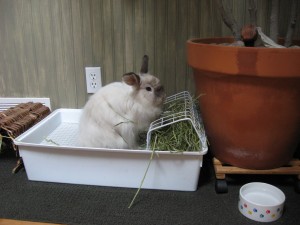 Rabbits can be litter trained. This statement takes many people by surprise. And it’s not just for the young, you really can teach an old “dog” or in this case, rabbit, new tricks. Rabbits are intelligent, clean and creatures of habit. They like to ‘go’ in the same spot, which will work to your advantage when you are trying to litter train your bunny.
Rabbits can be litter trained. This statement takes many people by surprise. And it’s not just for the young, you really can teach an old “dog” or in this case, rabbit, new tricks. Rabbits are intelligent, clean and creatures of habit. They like to ‘go’ in the same spot, which will work to your advantage when you are trying to litter train your bunny.
To litter train your bunny, start by placing a litter box inside your bunny’s cage or pen, in the corner she has chosen as her ‘bathroom’ corner.
As you increase your bunny’s supervised exercise time, you will want to make sure that she has access to one (or more) litter boxes (besides the one in her cage) in her exercise area. She will likely dictate the placement of these litter boxes by choosing a ‘bathroom’ corner in her exercise area. Hopefully, she will choose a spot that is convenient to the rest of the household. If not, you can try to convince her to change her mind by putting the box in her choice spot, and gradually moving it until it is where you would like. Sometimes, however, it is easier to oblige a stubborn bunny than to try to change a chosen litter box spot. After your bunny is using the litter box regularly, you can decrease the number of litter boxes she has access to until you have one box in her cage and one box in her exercise area.
Litter Training Tips:
- Young and adolescent rabbits will not have perfect litter habits all the time. They are still growing physically and mentally, so accidents are bound to happen. Be patient, they will improve as they mature. Always praise your bunny for a job well done and never scolded or hit your bunny because she had an accident.
- Unspayed and unneutered rabbits are much harder to litter train than altered rabbits. By 4 – 6 months of age, a rabbit’s hormones are telling him to “mark” his territory. It’s sad that many rabbits are put up for adoption because their owners didn’t realize that having them spayed or neutered can stop (or at least lessen) a lot of hormonal based negative behaviour and make the rabbit a much happier, healthier pet.
- Your house is new and exciting. Even a spayed or neutered bun will become looser with their litter box habits until they’ve settled in. Keeping a close eye on a newly exploring bunny will help prevent accidents before they happen.
- Keep those litter boxes clean! Your bunny’s litter box should to be cleaned everyday or every other day. Simply wash the litter box with white vinegar and rinse with water to neutralize the odour. Vinegar also works well to clean those accidents on your carpet and tile flooring. Rabbit urine has a strong odour due to it’s high alkaline level, and controlling the smell will make both you and the rabbit much happier.
- Sometimes too much freedom too soon can contribute to poor litter box habits. Gradually increase your bunny’s freedom, after she is using the litter box regularly. If your bunny has access to more than one room, give her access to more then one box.
- Put some hay at one end of the litter box to encourage your rabbit to hop into the box. Hay makes the box a more interesting place to visit. Some rabbits will spend hours munching on hay in their litter boxes. In addition, many rabbits will urinate or defecate while they eat.
- When bonding a new couple or introducing a new animal, your rabbit’s litter box habits will fall be the way side until he feels order has been restored to his life.
- Be consistent. Bunnies like a structured routine.
- Be patient. When your rabbit becomes more comfortable with you and her environment, and with maturity, her habits will improve. Good litter box habits aren’t going to happen overnight, but they will happen.
- If your rabbit is having prolonged problems achieving good litter box habits or has previously had excellent habits that have diminished, there are some factors to consider. Has his environment changed or a stress factor, like new animals, people, furniture etc, been added? Or is it a physical problem like a urinary tract infection that requires veterinary care?
- The size of the litter box should be determined by the size of the bunny as well as by the size of the pen or cage. You will still need room for food, toys, water and a place for the rabbit to lay down. Many buns like to be able to stretch out in their litter boxes, so as they grow the box will need to grow, too. If your bunny is kicking litter out of the box or urinating over the edge of the box, try a hooded cat-type litter box.
- If you are having a hard time training your bunny, try a new brand of litter.
What type of litter should I use?
Since bunnies spend a lot of time in their litterboxes, finding a safe litter is important. The following types of litter are acceptable for use in your rabbit’s litterbox:
- Litters made of aspen bark.
- Horse Stall Bedding pellets (compressed softwood) or Woodstove Pellets (compressed hardwood). Available at stores that horse supplies/tack, sell wood stoves or some Home Depots.
- Newspaper with plain hay over top. Using hay and newspaper in your rabbit’s box can be very economical. If you choose this option, the litterbox will need to be cleaned every day to prevent odours.
- Products made from recycled, shredded or compressed newspaper, such as Fresh News or Carefresh, are an excellent choice. These litters are nontoxic and absorbent. They also control odours well.
Things to consider when choosing a litter:
- Corn cob bedding or litter may cause a blockage if ingested. Rabbits can’t easily digest pieces of corn.
- Clumping cat litter may cause blockages if ingested.
- Cedar and pine wood shavings do not control odours well, and may lead to liver damage or respiratory problems. In addition, these litters are messy.
- CatWorks Litter (by the makers of CareFresh) contains zinc oxide, which may cause zinc poisioning if ingested. This product is not intended for use as rabbit litter.
- Do not use any litter that your rabbit enjoys feasting on (with the exception of hay over top of newspaper).

